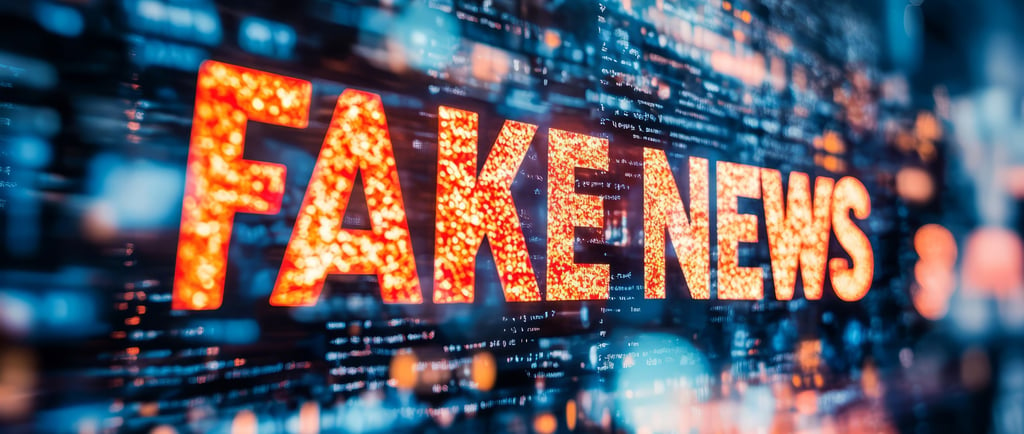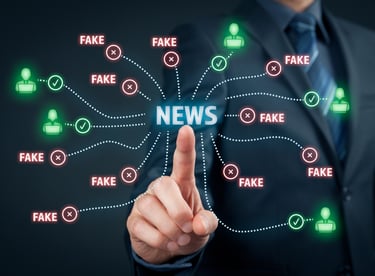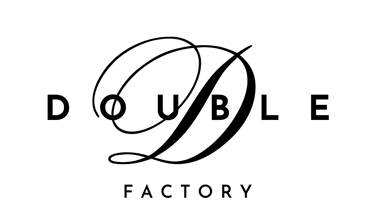Debunking the Myths: Fighting Disinformation in the Digital Age
Combat fake news in a rapidly evolving digital era.
DISINFORMATION
12/3/20244 min read


In today’s interconnected world, information flows faster than ever before. News articles, viral videos, tweets, and posts spread across the globe in mere seconds. While this unprecedented access to information can empower and enlighten, it also comes with a dark side: the proliferation of disinformation. The rise of fake news, hoaxes, and misleading content has become a global problem, challenging the public’s ability to discern fact from fiction. In this blog, we’ll explore the roots of disinformation, why it spreads so effectively, and what we can do to combat it.
What Is Disinformation, and Why Should We Care?
Disinformation refers to deliberately misleading or false information created to deceive people. Unlike misinformation, which is false information shared without malicious intent, disinformation is calculated and often serves political, financial, or social agendas. From viral conspiracy theories to fabricated news stories, disinformation undermines trust in media, institutions, and even each other.
Why is this such a pressing issue? Because disinformation has real-world consequences. It can sway elections, incite violence, damage reputations, and exacerbate public health crises. For instance, during the COVID-19 pandemic, false claims about cures and vaccines fueled confusion and mistrust, hindering global efforts to control the virus.
How Does Disinformation Spread So Quickly?
In the digital age, social media platforms have become the primary battleground for disinformation. Algorithms designed to maximize engagement often prioritize sensational or emotionally charged content, which disinformation frequently embodies. Here are some key reasons why disinformation spreads so effectively:
The Virality Factor: Fake stories are often crafted to provoke strong emotions—anger, fear, or even humor. These emotions drive people to share content without verifying its accuracy.
Echo Chambers: Social media creates bubbles where people are exposed primarily to views that align with their own. This reinforcement of beliefs makes it harder to challenge false narratives.
Trust in Familiar Sources: Many people trust content shared by friends and family more than traditional news outlets, even if the original source is dubious.
Information Overload: The sheer volume of content online makes it difficult to verify everything. Many users resort to skimming headlines or snippets, increasing the likelihood of sharing misleading information.
The Role of Media in Combating Disinformation
Traditional and digital media play a crucial role in shaping public understanding of global events. However, the media landscape itself has been both a contributor to and a victim of disinformation. To combat this issue, responsible journalism and transparency are essential. Here’s how:
Fact-Checking Initiatives: Many organizations now prioritize fact-checking as part of their reporting process. Dedicated teams investigate viral claims and publish detailed analyses to debunk falsehoods.
Transparency in Reporting: Clearly citing sources and distinguishing between opinion pieces and factual reporting can help rebuild public trust.
Educating Audiences: Media outlets can contribute to public awareness by teaching audiences how to identify fake news and verify sources.
The Power of Technology in Fighting Fake News
Ironically, while technology has amplified the spread of disinformation, it also offers tools to counter it. Here are some promising tech-driven solutions:
AI-Powered Fact-Checking: Artificial intelligence can quickly analyze content, flagging potential falsehoods and identifying patterns of disinformation.
Content Moderation: Social media platforms are increasingly investing in moderation technologies to detect and remove harmful content.
Media Literacy Tools: Apps and browser extensions that verify the credibility of sources and flag dubious claims are becoming more accessible.
Blockchain for Verification: Blockchain technology could help create tamper-proof records of information, making it easier to verify the authenticity of news and media.
Practical Tips for Individuals
While systemic solutions are essential, individuals also have a role to play in combating disinformation. Here are some practical steps you can take:
Verify Before Sharing: Always check the source and corroborate the information with trusted outlets before sharing it.
Be Skeptical of Sensational Headlines: If a headline seems too outrageous or emotionally charged, it’s worth digging deeper.
Diversify Your News Sources: Relying on a single source of news can limit your perspective. Consuming news from various outlets helps provide a more balanced view.
Educate Yourself and Others: Share tips on spotting fake news with friends and family. Encourage critical thinking and media literacy.
Report False Content: Most social media platforms allow users to flag and report misleading or harmful posts.
Real-World Examples of Disinformation
To understand the impact of disinformation, let’s look at some high-profile examples:
Pizzagate: In 2016, a conspiracy theory falsely claimed that a Washington, D.C., pizzeria was the center of a child trafficking ring linked to political figures. The hoax led to a man firing a gun inside the restaurant, illustrating how online lies can manifest in real-world violence.
COVID-19 Myths: From claims that 5G networks spread the virus to false “cures” involving bleach, pandemic-related disinformation sowed fear and confusion worldwide.
Election Interference: Disinformation campaigns during elections—such as false claims about voting procedures—aim to suppress voter turnout or delegitimize results.
A Global Effort to Tackle Disinformation
Addressing disinformation is a collective effort that requires collaboration across governments, tech companies, media, and civil society. Here are some global initiatives making strides:
Regulatory Frameworks: Countries are introducing laws to hold platforms accountable for spreading harmful content while balancing free speech considerations.
International Collaboration: Organizations like the United Nations and the European Union are working to establish guidelines and share best practices.
Public Awareness Campaigns: Governments and NGOs are launching initiatives to educate the public about the dangers of disinformation.
The Challenges Ahead
Despite these efforts, fighting disinformation remains an uphill battle. Key challenges include:
Balancing Free Speech: Ensuring that measures to curb disinformation do not infringe on freedom of expression.
Evolving Tactics: Disinformation tactics are becoming increasingly sophisticated, including the use of deepfakes and AI-generated content.
Global Coordination: Disinformation knows no borders, making international collaboration essential but complex.
A Call to Action
Disinformation is more than just an online nuisance; it’s a societal challenge that demands urgent action. By fostering media literacy, leveraging technology, and promoting transparency, we can begin to rebuild trust and protect the integrity of information in the digital age. Each of us has a role to play—as consumers, sharers, and creators of content—in ensuring that truth prevails over falsehood.
In the end, the fight against disinformation is not just about debunking myths; it’s about safeguarding the foundation of an informed and democratic society. Let’s rise to the challenge.
Share this post




